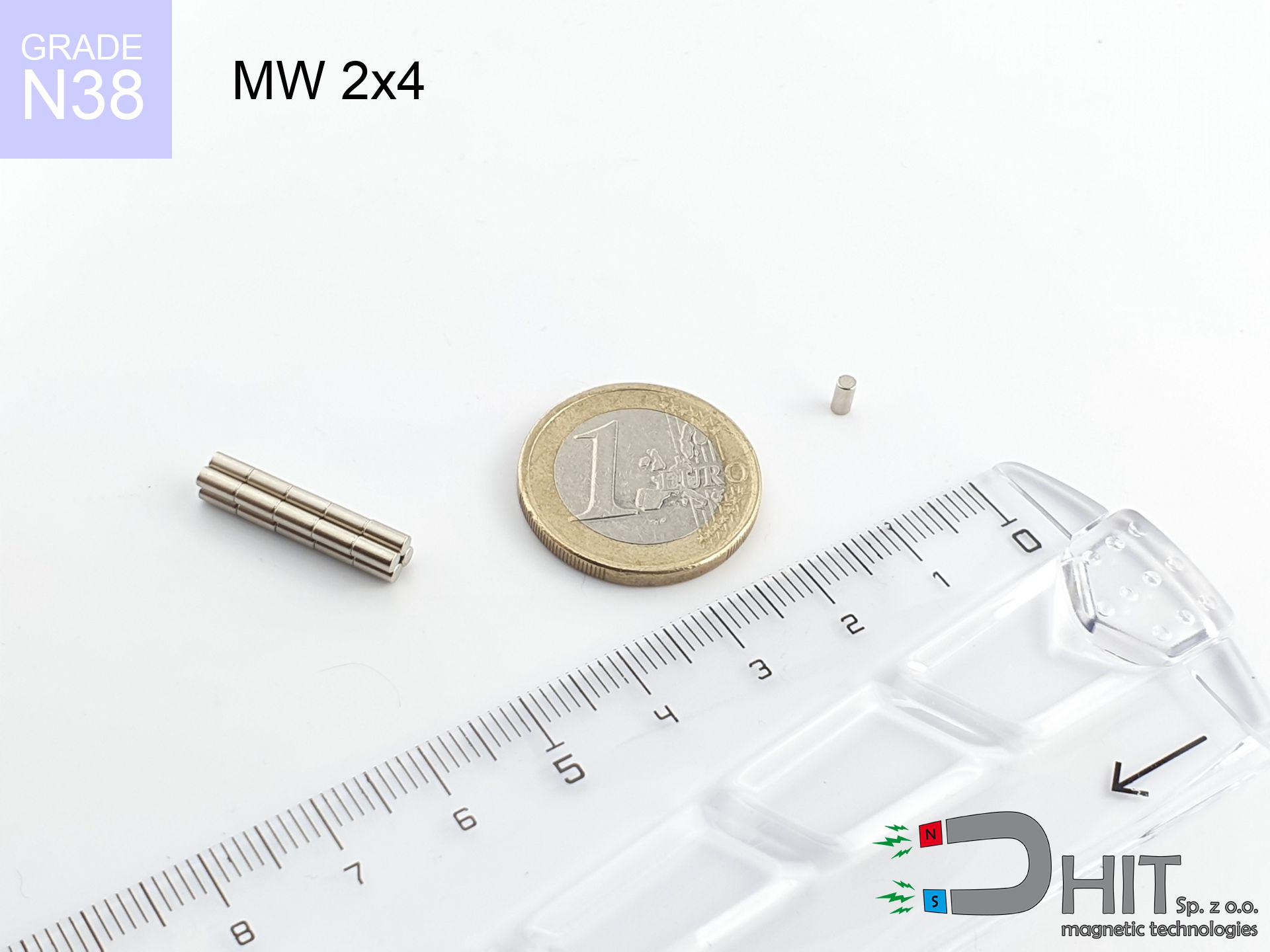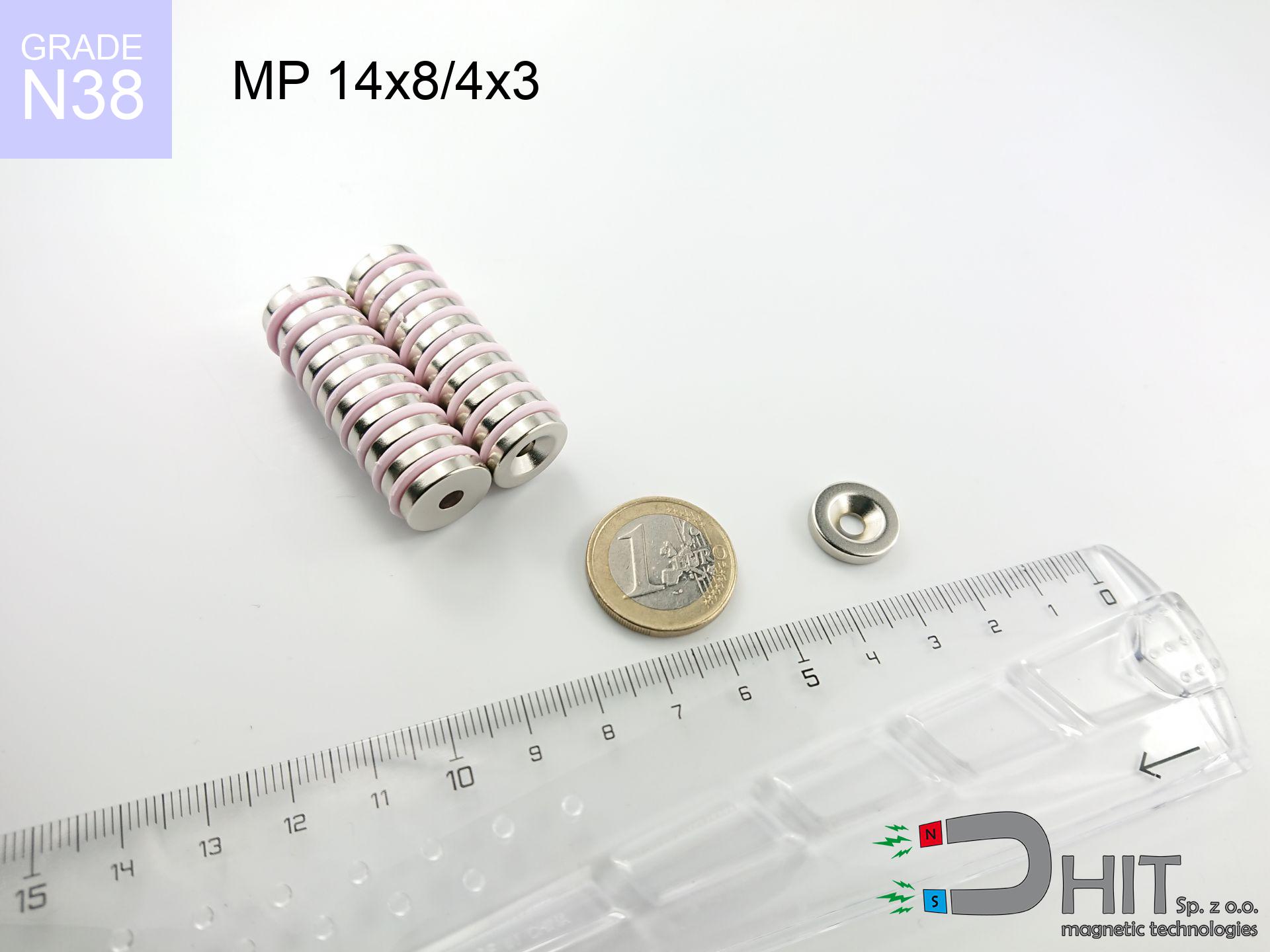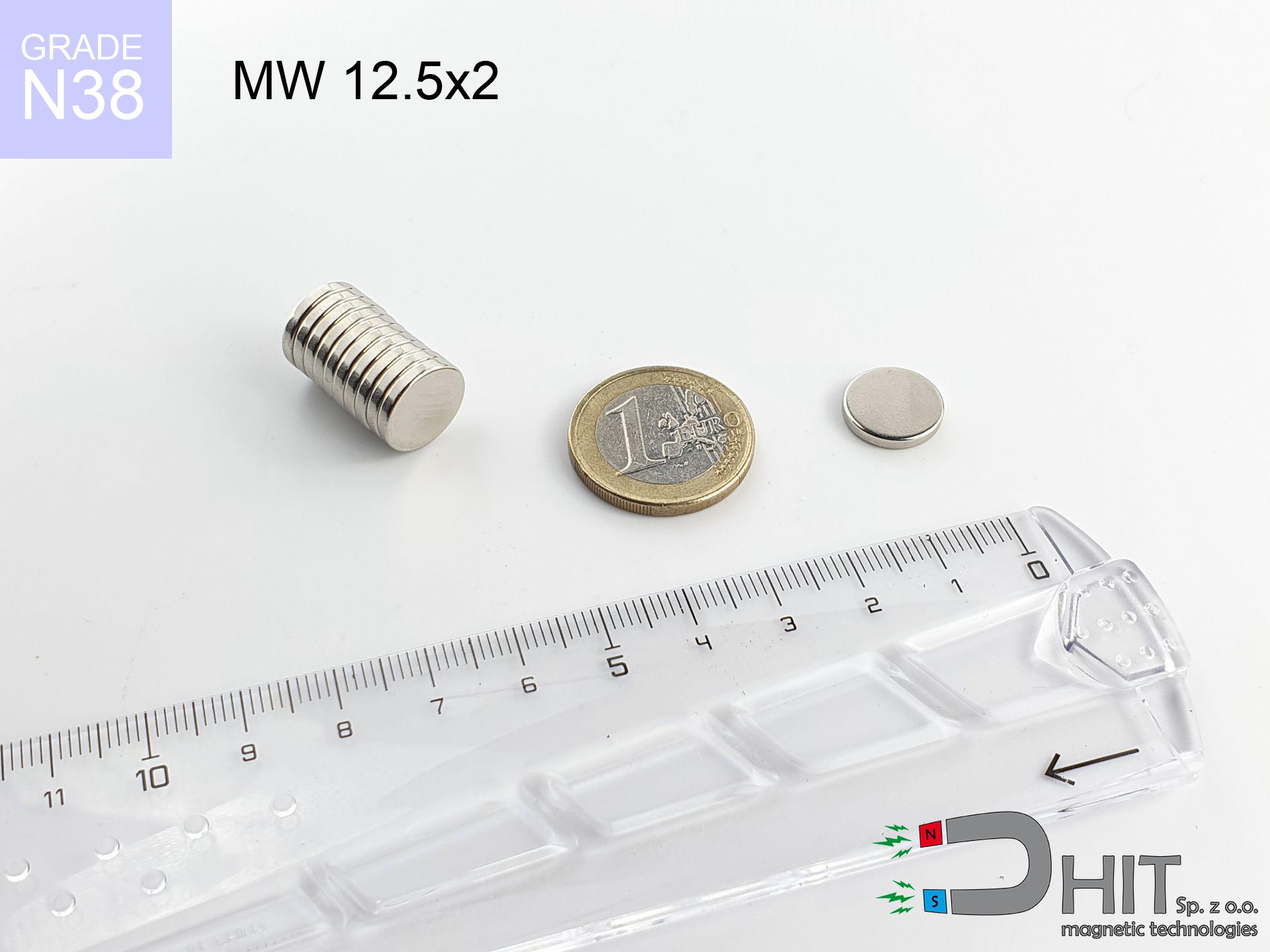MW 2x4 / N38 - cylindrical magnet
cylindrical magnet
Catalog no 010055
GTIN/EAN: 5906301810544
Diameter Ø
2 mm [±0,1 mm]
Height
4 mm [±0,1 mm]
Weight
0.09 g
Magnetization Direction
↑ axial
Load capacity
0.09 kg / 0.86 N
Magnetic Induction
597.70 mT / 5977 Gs
Coating
[NiCuNi] Nickel
0.209 ZŁ with VAT / pcs + price for transport
0.1700 ZŁ net + 23% VAT / pcs
bulk discounts:
Need more?
Give us a call
+48 22 499 98 98
if you prefer send us a note using
inquiry form
the contact section.
Specifications and appearance of neodymium magnets can be calculated with our
modular calculator.
Orders submitted before 14:00 will be dispatched today!
Physical properties - MW 2x4 / N38 - cylindrical magnet
Specification / characteristics - MW 2x4 / N38 - cylindrical magnet
| properties | values |
|---|---|
| Cat. no. | 010055 |
| GTIN/EAN | 5906301810544 |
| Production/Distribution | Dhit sp. z o.o. |
| Country of origin | Poland / China / Germany |
| Customs code | 85059029 |
| Diameter Ø | 2 mm [±0,1 mm] |
| Height | 4 mm [±0,1 mm] |
| Weight | 0.09 g |
| Magnetization Direction | ↑ axial |
| Load capacity ~ ? | 0.09 kg / 0.86 N |
| Magnetic Induction ~ ? | 597.70 mT / 5977 Gs |
| Coating | [NiCuNi] Nickel |
| Manufacturing Tolerance | ±0.1 mm |
Magnetic properties of material N38
| properties | values | units |
|---|---|---|
| remenance Br [min. - max.] ? | 12.2-12.6 | kGs |
| remenance Br [min. - max.] ? | 1220-1260 | mT |
| coercivity bHc ? | 10.8-11.5 | kOe |
| coercivity bHc ? | 860-915 | kA/m |
| actual internal force iHc | ≥ 12 | kOe |
| actual internal force iHc | ≥ 955 | kA/m |
| energy density [min. - max.] ? | 36-38 | BH max MGOe |
| energy density [min. - max.] ? | 287-303 | BH max KJ/m |
| max. temperature ? | ≤ 80 | °C |
Physical properties of sintered neodymium magnets Nd2Fe14B at 20°C
| properties | values | units |
|---|---|---|
| Vickers hardness | ≥550 | Hv |
| Density | ≥7.4 | g/cm3 |
| Curie Temperature TC | 312 - 380 | °C |
| Curie Temperature TF | 593 - 716 | °F |
| Specific resistance | 150 | μΩ⋅cm |
| Bending strength | 250 | MPa |
| Compressive strength | 1000~1100 | MPa |
| Thermal expansion parallel (∥) to orientation (M) | (3-4) x 10-6 | °C-1 |
| Thermal expansion perpendicular (⊥) to orientation (M) | -(1-3) x 10-6 | °C-1 |
| Young's modulus | 1.7 x 104 | kg/mm² |
Technical simulation of the magnet - report
Presented data represent the outcome of a engineering simulation. Values rely on algorithms for the class Nd2Fe14B. Operational parameters may deviate from the simulation results. Use these calculations as a preliminary roadmap for designers.
Table 1: Static force (force vs gap) - characteristics
MW 2x4 / N38
| Distance (mm) | Induction (Gauss) / mT | Pull Force (kg) | Risk Status |
|---|---|---|---|
| 0 mm |
5954 Gs
595.4 mT
|
0.09 kg / 90.0 g
0.9 N
|
low risk |
| 1 mm |
1696 Gs
169.6 mT
|
0.01 kg / 7.3 g
0.1 N
|
low risk |
| 2 mm |
570 Gs
57.0 mT
|
0.00 kg / 0.8 g
0.0 N
|
low risk |
| 3 mm |
256 Gs
25.6 mT
|
0.00 kg / 0.2 g
0.0 N
|
low risk |
| 5 mm |
82 Gs
8.2 mT
|
0.00 kg / 0.0 g
0.0 N
|
low risk |
| 10 mm |
15 Gs
1.5 mT
|
0.00 kg / 0.0 g
0.0 N
|
low risk |
| 15 mm |
5 Gs
0.5 mT
|
0.00 kg / 0.0 g
0.0 N
|
low risk |
| 20 mm |
2 Gs
0.2 mT
|
0.00 kg / 0.0 g
0.0 N
|
low risk |
| 30 mm |
1 Gs
0.1 mT
|
0.00 kg / 0.0 g
0.0 N
|
low risk |
| 50 mm |
0 Gs
0.0 mT
|
0.00 kg / 0.0 g
0.0 N
|
low risk |
Table 2: Shear force (wall)
MW 2x4 / N38
| Distance (mm) | Friction coefficient | Pull Force (kg) |
|---|---|---|
| 0 mm | Stal (~0.2) |
0.02 kg / 18.0 g
0.2 N
|
| 1 mm | Stal (~0.2) |
0.00 kg / 2.0 g
0.0 N
|
| 2 mm | Stal (~0.2) |
0.00 kg / 0.0 g
0.0 N
|
| 3 mm | Stal (~0.2) |
0.00 kg / 0.0 g
0.0 N
|
| 5 mm | Stal (~0.2) |
0.00 kg / 0.0 g
0.0 N
|
| 10 mm | Stal (~0.2) |
0.00 kg / 0.0 g
0.0 N
|
| 15 mm | Stal (~0.2) |
0.00 kg / 0.0 g
0.0 N
|
| 20 mm | Stal (~0.2) |
0.00 kg / 0.0 g
0.0 N
|
| 30 mm | Stal (~0.2) |
0.00 kg / 0.0 g
0.0 N
|
| 50 mm | Stal (~0.2) |
0.00 kg / 0.0 g
0.0 N
|
Table 3: Wall mounting (shearing) - behavior on slippery surfaces
MW 2x4 / N38
| Surface type | Friction coefficient / % Mocy | Max load (kg) |
|---|---|---|
| Raw steel |
µ = 0.3
30% Nominalnej Siły
|
0.03 kg / 27.0 g
0.3 N
|
| Painted steel (standard) |
µ = 0.2
20% Nominalnej Siły
|
0.02 kg / 18.0 g
0.2 N
|
| Oily/slippery steel |
µ = 0.1
10% Nominalnej Siły
|
0.01 kg / 9.0 g
0.1 N
|
| Magnet with anti-slip rubber |
µ = 0.5
50% Nominalnej Siły
|
0.05 kg / 45.0 g
0.4 N
|
Table 4: Steel thickness (substrate influence) - power losses
MW 2x4 / N38
| Steel thickness (mm) | % power | Real pull force (kg) |
|---|---|---|
| 0.5 mm |
|
0.01 kg / 9.0 g
0.1 N
|
| 1 mm |
|
0.02 kg / 22.5 g
0.2 N
|
| 2 mm |
|
0.05 kg / 45.0 g
0.4 N
|
| 5 mm |
|
0.09 kg / 90.0 g
0.9 N
|
| 10 mm |
|
0.09 kg / 90.0 g
0.9 N
|
Table 5: Thermal stability (stability) - resistance threshold
MW 2x4 / N38
| Ambient temp. (°C) | Power loss | Remaining pull | Status |
|---|---|---|---|
| 20 °C | 0.0% |
0.09 kg / 90.0 g
0.9 N
|
OK |
| 40 °C | -2.2% |
0.09 kg / 88.0 g
0.9 N
|
OK |
| 60 °C | -4.4% |
0.09 kg / 86.0 g
0.8 N
|
OK |
| 80 °C | -6.6% |
0.08 kg / 84.1 g
0.8 N
|
|
| 100 °C | -28.8% |
0.06 kg / 64.1 g
0.6 N
|
Table 6: Two magnets (attraction) - field range
MW 2x4 / N38
| Gap (mm) | Attraction (kg) (N-S) | Repulsion (kg) (N-N) |
|---|---|---|
| 0 mm |
0.69 kg / 687 g
6.7 N
6 090 Gs
|
N/A |
| 1 mm |
0.21 kg / 208 g
2.0 N
6 559 Gs
|
0.19 kg / 187 g
1.8 N
~0 Gs
|
| 2 mm |
0.06 kg / 56 g
0.5 N
3 391 Gs
|
0.05 kg / 50 g
0.5 N
~0 Gs
|
| 3 mm |
0.02 kg / 17 g
0.2 N
1 883 Gs
|
0.02 kg / 15 g
0.2 N
~0 Gs
|
| 5 mm |
0.00 kg / 3 g
0.0 N
743 Gs
|
0.00 kg / 0 g
0.0 N
~0 Gs
|
| 10 mm |
0.00 kg / 0 g
0.0 N
165 Gs
|
0.00 kg / 0 g
0.0 N
~0 Gs
|
| 20 mm |
0.00 kg / 0 g
0.0 N
30 Gs
|
0.00 kg / 0 g
0.0 N
~0 Gs
|
| 50 mm |
0.00 kg / 0 g
0.0 N
3 Gs
|
0.00 kg / 0 g
0.0 N
~0 Gs
|
Table 7: Protective zones (electronics) - precautionary measures
MW 2x4 / N38
| Object / Device | Limit (Gauss) / mT | Safe distance |
|---|---|---|
| Pacemaker | 5 Gs (0.5 mT) | 2.0 cm |
| Hearing aid | 10 Gs (1.0 mT) | 1.5 cm |
| Timepiece | 20 Gs (2.0 mT) | 1.0 cm |
| Phone / Smartphone | 40 Gs (4.0 mT) | 1.0 cm |
| Remote | 50 Gs (5.0 mT) | 1.0 cm |
| Payment card | 400 Gs (40.0 mT) | 0.5 cm |
| HDD hard drive | 600 Gs (60.0 mT) | 0.5 cm |
Table 8: Collisions (cracking risk) - warning
MW 2x4 / N38
| Start from (mm) | Speed (km/h) | Energy (J) | Predicted outcome |
|---|---|---|---|
| 10 mm |
31.89 km/h
(8.86 m/s)
|
0.00 J | |
| 30 mm |
55.24 km/h
(15.34 m/s)
|
0.01 J | |
| 50 mm |
71.31 km/h
(19.81 m/s)
|
0.02 J | |
| 100 mm |
100.85 km/h
(28.01 m/s)
|
0.04 J |
Table 9: Corrosion resistance
MW 2x4 / N38
| Technical parameter | Value / Description |
|---|---|
| Coating type | [NiCuNi] Nickel |
| Layer structure | Nickel - Copper - Nickel |
| Layer thickness | 10-20 µm |
| Salt spray test (SST) ? | 24 h |
| Recommended environment | Indoors only (dry) |
Table 10: Electrical data (Flux)
MW 2x4 / N38
| Parameter | Value | SI Unit / Description |
|---|---|---|
| Magnetic Flux | 209 Mx | 2.1 µWb |
| Pc Coefficient | 1.21 | High (Stable) |
Table 11: Submerged application
MW 2x4 / N38
| Environment | Effective steel pull | Effect |
|---|---|---|
| Air (land) | 0.09 kg | Standard |
| Water (riverbed) |
0.10 kg
(+0.01 kg Buoyancy gain)
|
+14.5% |
1. Vertical hold
*Caution: On a vertical wall, the magnet holds only a fraction of its perpendicular strength.
2. Steel thickness impact
*Thin steel (e.g. computer case) drastically reduces the holding force.
3. Thermal stability
*For standard magnets, the critical limit is 80°C.
4. Demagnetization curve and operating point (B-H)
chart generated for the permeance coefficient Pc (Permeance Coefficient) = 1.21
This simulation demonstrates the magnetic stability of the selected magnet under specific geometric conditions. The solid red line represents the demagnetization curve (material potential), while the dashed blue line is the load line based on the magnet's geometry. The Pc (Permeance Coefficient), also known as the load line slope, is a dimensionless value that describes the relationship between the magnet's shape and its magnetic stability. The intersection of these two lines (the black dot) is the operating point — it determines the actual magnetic flux density generated by the magnet in this specific configuration. A higher Pc value means the magnet is more 'slender' (tall relative to its area), resulting in a higher operating point and better resistance to irreversible demagnetization caused by external fields or temperature. A value of 0.42 is relatively low (typical for flat magnets), meaning the operating point is closer to the 'knee' of the curve — caution is advised when operating at temperatures near the maximum limit to avoid strength loss.
Chemical composition
| iron (Fe) | 64% – 68% |
| neodymium (Nd) | 29% – 32% |
| boron (B) | 1.1% – 1.2% |
| dysprosium (Dy) | 0.5% – 2.0% |
| coating (Ni-Cu-Ni) | < 0.05% |
Environmental data
| recyclability (EoL) | 100% |
| recycled raw materials | ~10% (pre-cons) |
| carbon footprint | low / zredukowany |
| waste code (EWC) | 16 02 16 |
See also products
Advantages and disadvantages of neodymium magnets.
Strengths
- Their magnetic field is durable, and after approximately ten years it drops only by ~1% (according to research),
- They maintain their magnetic properties even under close interference source,
- Thanks to the reflective finish, the coating of nickel, gold-plated, or silver gives an clean appearance,
- Neodymium magnets achieve maximum magnetic induction on a their surface, which increases force concentration,
- Made from properly selected components, these magnets show impressive resistance to high heat, enabling them to function (depending on their form) at temperatures up to 230°C and above...
- Possibility of custom shaping and modifying to complex conditions,
- Huge importance in future technologies – they are commonly used in hard drives, drive modules, precision medical tools, as well as complex engineering applications.
- Compactness – despite small sizes they offer powerful magnetic field, making them ideal for precision applications
Disadvantages
- At very strong impacts they can break, therefore we advise placing them in strong housings. A metal housing provides additional protection against damage, as well as increases the magnet's durability.
- Neodymium magnets decrease their strength under the influence of heating. As soon as 80°C is exceeded, many of them start losing their power. Therefore, we recommend our special magnets marked [AH], which maintain durability even at temperatures up to 230°C
- Magnets exposed to a humid environment can corrode. Therefore while using outdoors, we suggest using water-impermeable magnets made of rubber, plastic or other material resistant to moisture
- We suggest casing - magnetic mechanism, due to difficulties in producing threads inside the magnet and complicated shapes.
- Potential hazard to health – tiny shards of magnets pose a threat, when accidentally swallowed, which is particularly important in the aspect of protecting the youngest. Furthermore, small elements of these products are able to be problematic in diagnostics medical after entering the body.
- Higher cost of purchase is a significant factor to consider compared to ceramic magnets, especially in budget applications
Lifting parameters
Breakaway strength of the magnet in ideal conditions – what contributes to it?
- on a plate made of mild steel, effectively closing the magnetic field
- possessing a thickness of at least 10 mm to ensure full flux closure
- characterized by lack of roughness
- without any air gap between the magnet and steel
- during detachment in a direction vertical to the plane
- at conditions approx. 20°C
Determinants of practical lifting force of a magnet
- Air gap (between the magnet and the metal), because even a very small distance (e.g. 0.5 mm) leads to a reduction in lifting capacity by up to 50% (this also applies to paint, rust or debris).
- Load vector – highest force is available only during perpendicular pulling. The resistance to sliding of the magnet along the surface is usually several times smaller (approx. 1/5 of the lifting capacity).
- Element thickness – for full efficiency, the steel must be adequately massive. Thin sheet restricts the attraction force (the magnet "punches through" it).
- Material type – ideal substrate is pure iron steel. Cast iron may attract less.
- Surface condition – ground elements ensure maximum contact, which improves force. Uneven metal weaken the grip.
- Thermal factor – high temperature reduces magnetic field. Too high temperature can permanently damage the magnet.
Lifting capacity testing was conducted on plates with a smooth surface of suitable thickness, under a perpendicular pulling force, in contrast under attempts to slide the magnet the holding force is lower. In addition, even a slight gap between the magnet and the plate lowers the holding force.
Safe handling of NdFeB magnets
Threat to navigation
An intense magnetic field interferes with the functioning of magnetometers in phones and navigation systems. Do not bring magnets close to a device to prevent breaking the sensors.
Do not overheat magnets
Keep cool. Neodymium magnets are sensitive to heat. If you need operation above 80°C, inquire about HT versions (H, SH, UH).
Magnets are brittle
NdFeB magnets are sintered ceramics, which means they are fragile like glass. Impact of two magnets leads to them shattering into small pieces.
Warning for allergy sufferers
Medical facts indicate that the nickel plating (standard magnet coating) is a potent allergen. If you have an allergy, prevent touching magnets with bare hands and choose versions in plastic housing.
Electronic devices
Data protection: Strong magnets can damage payment cards and delicate electronics (heart implants, medical aids, mechanical watches).
ICD Warning
Patients with a ICD have to maintain an absolute distance from magnets. The magnetism can interfere with the functioning of the life-saving device.
This is not a toy
Only for adults. Tiny parts pose a choking risk, leading to intestinal necrosis. Keep away from children and animals.
Machining danger
Fire hazard: Neodymium dust is highly flammable. Avoid machining magnets in home conditions as this risks ignition.
Finger safety
Watch your fingers. Two large magnets will join immediately with a force of several hundred kilograms, crushing everything in their path. Exercise extreme caution!
Do not underestimate power
Handle with care. Neodymium magnets attract from a long distance and connect with massive power, often faster than you can move away.





![UMP 97x40 [M8+M10] GW F300 kg / N38 - search holder UMP 97x40 [M8+M10] GW F300 kg / N38 - search holder](https://cdn3.dhit.pl/graphics/products/ump97x40-m8+m10-gw-f-300-kg-kic.jpg)



